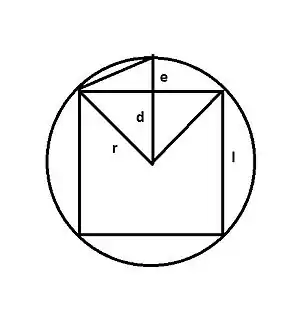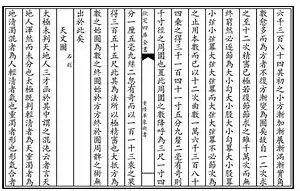

Zhao Youqin's π algorithm was an algorithm devised by Yuan dynasty Chinese astronomer and mathematician Zhao Youqin (赵友钦, ? – 1330) to calculate the value of π in his book Ge Xiang Xin Shu (革象新书).
Algorithm
Zhao Youqin started with an inscribed square in a circle with radius r.[1]
If denotes the length of a side of the square, draw a perpendicular line d from the center of the circle to side l. Let e denotes r − d. Then from the diagram:
Extend the perpendicular line d to dissect the circle into an octagon; denotes the length of one side of octagon.
Let denotes the length of a side of hexadecagon
similarly
Proceeding in this way, he at last calculated the side of a 16384-gon, multiplying it by 16384 to obtain 3141.592 for a circle with diameter = 1000 units, or
He multiplied this number by 113 and obtained 355. From this he deduced that of the traditional values of π, that is 3, 3.14, 22/7 and 355/113, the last is the most exact.[2]
See also
References
- ↑ Yoshio Mikami, Development of Mathematics in China and Japan, Chapter 20, The Studies about the Value of π etc., pp 135–138
- ↑ Yoshio Mikami, p136